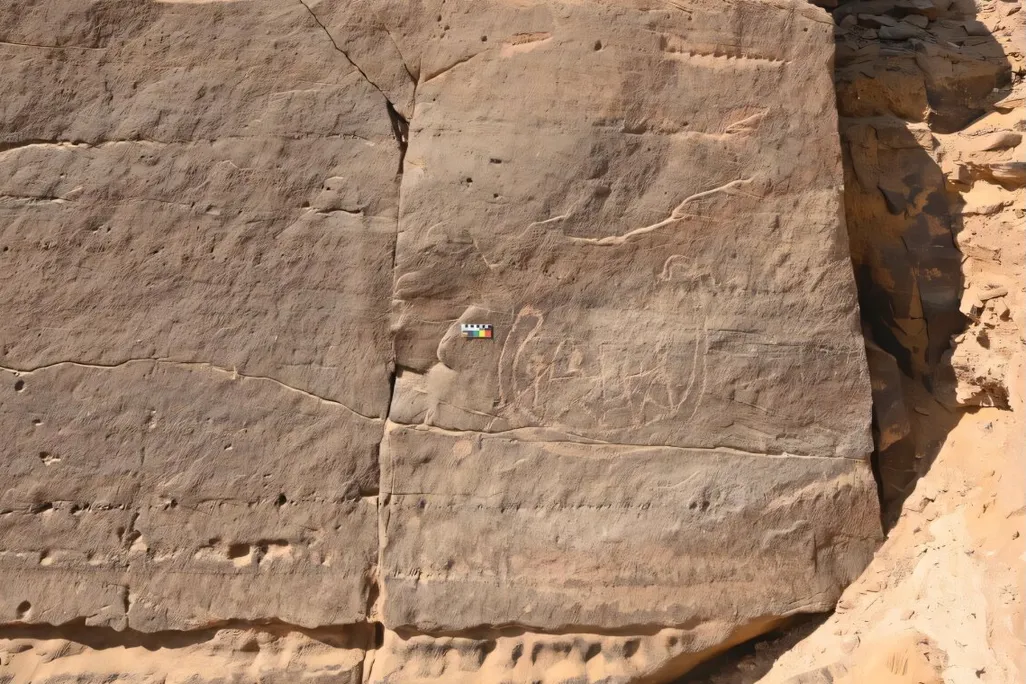Does This Ancient Rock Carving Depict One of Egypt’s Earliest Rulers?
New research suggests the engraving, which shows an elite individual sitting in a boat, may be up to 5,100 years old

Archaeologists have discovered an ancient rock carving of a boat on the banks of the Nile in Egypt. New research suggests that the engraving is up to 5,100 years old, predating Egypt’s First Dynasty.
According to the study, which was published this month in the journal Antiquity, the carving features seven people: Five figures tug the boat to the right, while a standing figure inside the boat holds an oar. Meanwhile, a seated figure in the boat appears to be inside a palanquin, “a status symbol reserved for individuals of high rank,” writes La Brújula Verde’s Guillermo Carvajal.
Quick fact: How many Egyptian dynasties were there?
Menes is said to have founded the first of 31 dynasties that would rule ancient Egypt, each leaving its own unique mark on history.
“Boats are among the most frequently recurring motifs in Egyptian iconography,” study author Dorian Vanhulle, director and curator of the Musée du Malgré-Tout in Belgium, says in a statement from Antiquity.
After comparing the petroglyph to other depictions of boats from ancient Egyptian art, Vanhulle dated it to the late fourth millennium B.C.E. He says that during Egypt’s Predynastic and Protodynastic periods (around 4500 to 3085 B.C.E.), “the boat [was] ubiquitous and invested with complex ideological and symbolic meanings.”
In Predynastic Egypt, the land was occupied by groups descended from Paleolithic peoples of northeastern Africa. Smaller societies were governed by rulers, and early systems of writing developed. It wasn’t until around 3000 B.C.E. that Egypt’s First Dynasty began.
/https://tf-cmsv2-smithsonianmag-media.s3.amazonaws.com/filer_public/b7/3f/b73f0e2b-1093-4933-8557-a96db8daff21/illustration_of_the_rock_art_credit-_dorian_vanhulle_akap.jpeg)
According to tradition, a king named Menes brought together Upper and Lower Egypt under his monarchy. But the details of how Egypt was first united under one rule aren’t well understood.
“State formation in ancient Egypt and the processes that led to it are still difficult to conceptualize,” says Vanhulle in the statement. “The rock art of the Lower Nile Valley has the potential to help identify and analyze the earliest forms of political power in this region, and how the landscape was exploited to express and consolidate authority.”
The boat in the petroglyph is shaped like a sickle, Vanhulle writes. The front of the boat is facing north, the same direction the Nile flows. Why, then, are five people towing it? Per the study, ceremonial barques “were presumably always dragged.”
The petroglyph’s seated figure appears to have a long chin. This could be a false beard, which many kings from the First Dynasty wore, as Vanhulle writes in the study. The figure may also be wearing a headdress. However, the petroglyph doesn’t include a serekh, a hieroglyph featuring the falcon god Horus, which is a common symbol in First Dynasty engravings. As such, Vanhulle thinks the seated figure may be a ruler from before the First Dynasty.
/https://tf-cmsv2-smithsonianmag-media.s3.amazonaws.com/filer_public/fe/39/fe39bfb6-70c9-4977-9310-3130fae49872/rock_engraving_of_a_protodynastic_boat_from_wadi_abu_subeira_credit-_dorian_vanhulle_akap.jpeg)
The serekh’s absence is “a relevant detail,” Alejandro Jiménez Serrano, an Egyptologist at the University of Jaén in Spain who wasn’t involved in the research, tells Live Science’s Laura Geggel in an email. “This could indicate that the seated figure predates the widespread use of this royal symbol in official rock art.”
While experts are hesitant to make assumptions, they say the seated individual appears to be some sort of elite. There’s a “limited corpus of Protodynastic rock art,” which makes this discovery “particularly significant, because it depicts a seated figure in a processional boat, interpreted as a possible representative of authority,” Jiménez Serrano adds.
As Vanhulle writes in the study, Egyptian rock art “was not an accidental practice but rather a social action that followed rules and had intrinsic meanings, functions and goals.” Historians think Egyptian royals may have commissioned petroglyphs to spread their influence. The new research suggests that this image may shed light on power structures during this period.
/https://tf-cmsv2-smithsonianmag-media.s3.amazonaws.com/accounts/headshot/Sonja_headshot.png)
